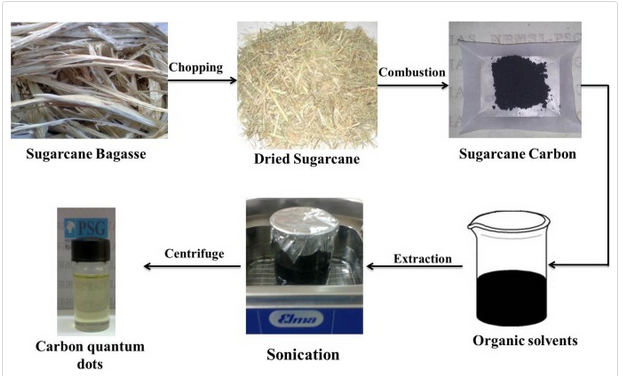Indian researchers have found a new use for sugarcane pulp—as a source of highly fluorescent carbon quantum dots. Their study was published in Applied Surface Science.
From Britain to Mexico, countries are considering sugar taxes to reduce consumption and curb the global obesity epidemic. In 2014, about 600 million people, roughly double the population of the US, were obese. Addressing the problem earlier this year, the World Health Organization pointed the finger at high sugar consumption, particularly through sugar-sweetened beverages.
At the same time, sugar industry associations and sugarcane growers warn for huge job losses if countries discourage their citizens from consuming sugar. In South Africa, for example, the industry warns that a mooted sugar tax will cut at least 60,000 jobs. This alternate use of sugarcane waste, or bagasse, could not only reduce the amount of agricultural waste contaminating the environment, but also offers a new revenue stream for farmers.

Green synthesis of sugarcane bagasse pulp into carbon quantum dots (Image by Thambiraj and Shankaran 2016, http://www.sciencedirect.com/science/article/pii/S0169433216317494)
“In our study, we developed a simple, low-cost and efficient method for green synthesis of fluorescent carbon quantum dots from sugarcane bagasse,” said Dr. Ravi Shankaran Dhesingh, co-author of the paper and associate professor at the National Center for Nanoscience and Nanotechnology at the University of Madras in Chennai.
These dots are tiny carbon nanoparticles which are about four nanometers across. For an idea of scale, 110 billion of these dots—more than all the stars in the Milky Way—would fit on the head of a pin. Because they emit light and are non-toxic, carbon quantum dots can serve as biosensors, in light-emitting diodes and even to deliver drugs around the human body. To produce these versatile nanoparticles, the Indian team cut the sugarcane bagasse into small pieces and sun-dried them for six days. After burning the dry bagasse, they chemically oxidized and exfoliated it.
Importantly, these sugarcane carbon quantum dots are just as good as those made using other methods. The study shows that they are just as fluorescent and bio-compatible as other carbon quantum dots. (Asian Scientist)

